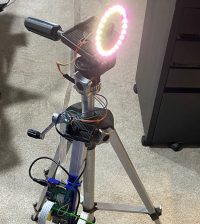- makeITcircular 2024 content launched – Part of Maker Faire Rome 2024Posted 2 weeks ago
- Application For Maker Faire Rome 2024: Deadline June 20thPosted 2 months ago
- Building a 3D Digital Clock with ArduinoPosted 7 months ago
- Creating a controller for Minecraft with realistic body movements using ArduinoPosted 7 months ago
- Snowflake with ArduinoPosted 8 months ago
- Holographic Christmas TreePosted 8 months ago
- Segstick: Build Your Own Self-Balancing Vehicle in Just 2 Days with ArduinoPosted 8 months ago
- ZSWatch: An Open-Source Smartwatch Project Based on the Zephyr Operating SystemPosted 9 months ago
- What is IoT and which devices to usePosted 9 months ago
- Maker Faire Rome Unveils Thrilling “Padel Smash Future” Pavilion for Sports EnthusiastsPosted 10 months ago
Mycroft Mark II: The Open Source Voice Assistant

Voice assistants are everywhere these days, with each company working to get its virtual assistant software running on as many speakers, phones, PCs, and other gadgets as possible.
Mycroft Mark II is actually the second speaker from Mycroft. The first hit Kickstarter in 2015 and shipped to backers in 2016.
It is a voice assistant platform that’s designed to work just like the others (Amazon Alexa, Apple Siri…) but it’s an open source project that places an emphasis on privacy. Mycroft sends your data to a cloud server to process requests, but the developers say they never save data unless you opt in, ,and never use your data for advertising purposes.
Specs for the Mycroft Mark II include a Xilinx quad-core processor, a 6-mic array for far-field voice detection, 10 watt stereo speakers with 2 inch drivers, WiFi, Bluetooth, a 3.5mm audio output, a microSD card slot, and a USB Type-A port.
Mycroft Mark II is more user-friendly than the first edition, it’s a consumer-ready speaker designed “for you and your family”, whatever your level of technical expertise.
It offers better sounds, improved voice detection, and an updated design, among other things. But it’s still an open hardware design that’s hacker-friendly, and it still runs open source software: you can find Mycroft’s software at Github. And if you don’t want to run it on Mycroft’s speaker, you can download and install Mycroft software on other hardware including a Raspberry Pi or other GNU/Linux computer.
You can reserve one for a pledge of $129, which makes the Mycroft Mark II about the same price as a Google Home smart speaker, although unlike Google’s speaker, the Mycroft speaker has a 4 inch IPS LCD touchscreen display.
There’s also a $99 Dev Kit option for folks that would prefer to just purchase key components and build their own case for the speaker.















